Digne-les-Bains
| Digne-les-Bains | ||
|---|---|---|
|
A general view of Digne-les-Bains in 2014 | ||
| ||
 Digne-les-Bains | ||
|
Location within Provence-A.-C.d'A. region  Digne-les-Bains | ||
| Coordinates: 44°05′36″N 6°14′11″E / 44.0933°N 6.2364°ECoordinates: 44°05′36″N 6°14′11″E / 44.0933°N 6.2364°E | ||
| Country | France | |
| Region | Provence-Alpes-Côte d'Azur | |
| Department | Alpes-de-Haute-Provence | |
| Arrondissement | Digne-les-Bains | |
| Intercommunality | Asse Bleone Verdon | |
| Government | ||
| • Mayor (2014–2020) | Patricia Granet Brunello | |
| Area1 | 117.07 km2 (45.20 sq mi) | |
| Population (2008)2 | 17,268 | |
| • Density | 150/km2 (380/sq mi) | |
| Time zone | CET (UTC+1) | |
| • Summer (DST) | CEST (UTC+2) | |
| INSEE/Postal code | 04070 / 04000 | |
| Elevation |
524–1,731 m (1,719–5,679 ft) (avg. 608 m or 1,995 ft) | |
|
1 French Land Register data, which excludes lakes, ponds, glaciers > 1 km² (0.386 sq mi or 247 acres) and river estuaries. 2 Population without double counting: residents of multiple communes (e.g., students and military personnel) only counted once. | ||
Digne-les-Bains (French: [diɲ le bɛ̃]) or simply and historically Digne (Occitan: Dinha (dei Banhs) in classical norm or Digno in Mistralian norm) is a commune of France, capital of the Alpes-de-Haute-Provence department, and situated in the region of Provence-Alpes-Côte d'Azur.
The name of the inhabitants is Dignois.
Geography
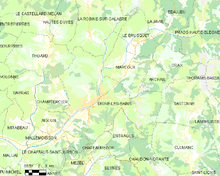
Site and location
Located on the edge of the Prealps of Digne and on both sides of the Bléone, which flows southwest through the middle of the commune and crosses the town; it forms part of the commune's northeastern and southwestern borders.
Digne-les-Bains is the capital of the Department of Alpes de Haute-Provence. Placed in the geographical centre of the Department, the commune is home to 17,400 inhabitants, making it one of the smaller prefectures of France by its population. The town centre is at 608 metres (1,995 ft) altitude.[1]
Digne is a sprawling commune in the plain formed around the Bléone Valley, given that the terrain that surrounds it is very rugged. The old town is built on a hill between the Bléone and the torrent of the hot springs, but the town has gradually extended in the three directions of the valleys, especially downstream. Its geographical location is quite remarkable, given that it lies at the edge of the Prealps, on a thrust fault that bears its name. A part of the town is completely enclosed in the Bléone Valley, while the town extends widely, on a gentler relief, downstream. With the annexation of neighbouring towns, especially downstream, the town extends over 8 kilometres (5.0 mi) in length.
- Panoramic views of Dignes-les-Bains
- General view of the city from west to east
- The old centre from west to east
- An aerial view of the centre from west to east
- An aerial view of the centre from the east, towards the direction of the Durance river
Neighbouring communes
The communes surrounding Digne-les-Bains are La Robine-sur-Galabre, Le Brusquet, Marcoux, Archail, Tartonne, Clumanc, Chaudon-Norante, Châteauredon, Le Chaffaut-Saint-Jurson, Aiglun, Champtercier and Thoard.
 |
Thoard | Barles | Marcoux Archail Draix |
 |
| Champtercier Barras |
|
Tartonne | ||
| ||||
| | ||||
| Aiglun Mallemoisson |
Châteauredon | Clumanc |
Geology and terrain
The commune, which is at the heart of the geology, has its specificities related to the ancient city built upstream of the cluse which the Bléone has pierced into the Nappe de Digne to dump in the tertiary basin of Valensole.[2]
The districts of the town cover the alluvium of the streams which converge upstream of the cluse. The most eastern suburbs joined a line of limestone hills with flint of the Carixian age, forming russet cliffs oriented to the south-west.[2]
The hot springs were captured, since ancient times, to the point where these carixian limestones are cut by the hack of the southernmost valley, descending from Entrages. Their healing powers are linked to their ascent along the gypsiferous Triassic levels of the sole thrust of the Nappe de Digne.[2]
The most visible mountain of the commune is Le Cousson at 1,516 metres (4,974 ft); the Bigué rises to 1,653 metres (5,423 ft).[3]
- Slab ammonites
 Marl of the Adret of Escure
Marl of the Adret of Escure
Many reliefs lie around Digne and are objectives for hikers.
- The Rocher de Neuf Heures [Rock of Nine o'clock]
- Three chapels (the Chapel of our Lady of Lourdes, the Chapel of Saint-Vincent, and the Chapel La Croix)
- The right bank of the Bléone (Park of the Haute-Provence Geological Reserve, along the Caguerenard path, paths to access the top of the slope (over 200 metres (660 ft) above the town) and the crest of Andran - Martignon - La Bigue.
- Trails to access the Basses Bâties de Cousson, and then Le Cousson
- The Chapel of Saint Pancrace
- Barre des Dourbes
Hydrography
In the Eaux-Chaudes Valley, there is one cold and eight hot springs used for hydrotherapy. Some are radioactive, and contain sulfides, chlorobromides, and arsenic.
The town is also crossed by the Bléone and the Mardaric rivers.
Channels of communication and transport
Road network
| N85 Route nationale 85 | ||
| Towards the Mediterranean Sea | Towards Grenoble | |
|---|---|---|
| Barrême | Digne-les-Bains | Mallemoisson |
Railway network
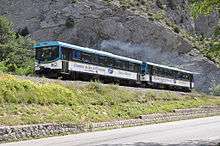
The town is served by Chemins de Fer de Provence via the Nice-Digne railway line, a narrow gauge line which operates daily. It is the Train des Pignes, which allows the railway to serve little inhabited places with many stations.
Public transport
Bus - Since 1992, Digne has the TUD (Urban Transport Digne), which manages the public transport. Initially with six buses, this service increased its vehicle fleet in 1998 with the acquisition of two buses powered by natural gas.
Currently, six bus routes are available to the people of Digne.[4]
Natural and technological risks
None of the 200 communes of the Department is in the zero seismic risk zone. Digne townships are located in zone 1b (low seismicity) of the 1991 deterministic classification, based on the historic earthquakes,[5] and in zone 4 (medium risk) according to the EC8 probabilistic classification 2011.[6] The town of Digne is also exposed to three other natural risks:[6]
- Forest fire
- Flooding (in the Bléone Valley) and in those of its tributaries;
- Land movement: all the western part of the municipality is covered by a medium to strong hazard.[7]
The town of Digne is also exposed to a risk of technological origin, that of transport of dangerous goods, by rail, road and pipeline.[8] With regard to the railway, the Saint-Auban to Digne railway line is disused and has no traffic; the line from Nice to Digne is used by passenger transport. Route nationale 85 and the departmental road RD 900 (former Route nationale 100) can be used for the road transport of dangerous goods.[9] Finally, the pipeline to supply natural gas is an additional risk factor to Digne.[10]
The foreseeable natural risk prevention plan (PPR) of the town was approved in 2008 for the risks of flooding, movement of land and earthquakes[8] and the DICRIM has existed since 2009.[11]
The commune has been the subject of several orders of natural disaster: in 1984 for an earthquake, and many times for floods, landslides and mudslides, and landslides due to drought.[6] Also included is a flood disaster prior to the orders: The waters of the Mardaric and Eaux-Chaudes which flooded the town in 1928, and the Bléone in 1973 which partially destroyed the bridge.[12] This destruction was caused by the breakdown of a jam created in the bed of the Bès, causing a wave of flooding.[13] Similarly, several massive landslides have happened in the history of the commune, for example on 24 December 1916, which caused the collapse of part of Courbons, and 2002-2003 at Villard-des-Dourbes.[14] Earthquakes have a long history in Digne. Retaining those macro-seismic events felt higher than level V on the MSK scale (sleepers awake, falling objects), we obtain the following list (the specified intensities are those felt in the town, the intensity may be stronger at epicentre):[15]
- The earthquake of 31 August 1684, an intensity felt Digne of V.5 and whose epicentre was located at Digne[16]
- The earthquake of 2 December 1872, an intensity felt V and whose epicentre was located at Digne[17]
- The earthquake of 20 September 1876, an intensity felt V.5 and whose epicentre was located at Digne[18]
- The earthquake of 23 February 1887, an intensity felt VII and whose epicentre was located in Bussana Vecchia (Piedmont)[19]
- The earthquake of 27 September 1911, an intensity felt V and whose epicentre was located at Barrême[20]
- The earthquake of 16 February 1915, an intensity felt V and a half and whose epicentre was located at Digne[21]
- The earthquake of 19 June 1984, of an intensity felt V and whose epicentre was located in Aiglum[22]
Attached communes
Courbons (Corbo, cited in the 13th century but the church is cited as 1180)[23] was attached to Digne in 1862.[24] The Priory of Sainte-Eugénie, ancestor of the parish church, was part of the chapter of Digne.[23] Jews installed here were massacred in 1335. Its fortifications were destroyed by Lesdiguières during the Wars of Religion (1590). It had 80 feus in 1315, 90 in 1471 and 507 inhabitants in 1765.[24]
Les Dourbes (De Dorbas, cited in 1035)[1] was attached to Digne in 1974, as an associated commune. The village is located on a barrier and a Motte-and-bailey castle was built in the 11th century.[25] It had 48 feus in 1315, 12 in 1471 and 249 inhabitants in 1765, 296 inhabitants in 1851, 62 in 1982.[26]
Gaubert (Galbertum, cited in 1180)[23] was attached to Digne in 1862.[27] The parish church was part of the chapter of Digne, who collected the tithe.[23] The square, defended by the Catholic League and Sautaire, was taken by Lavalette in 1591. It had 63 feus in 1315, 41 in 1471 and 456 inhabitants in 1765.[27]
Les Sieyes, or just Sieyes, for short (Lascieias, cited in the 13th century)[28] was attached to Digne in 1862. There were 10 feus in 1315, 13 in 1471 and 307 inhabitants in 1765.[28] The two priories, Sainte-Madeleine and Saint-Véran, were part of the chapter of Digne which received the tithes.[23]
During the Revolution, these four municipalities each had a patriotic society, all created after the end of 1792.[29]
Toponymy
The toponym Dinia is known from the 1st century AD (Ptolemy, Pliny the elder). Various hypotheses have been advanced. According to Papon, the name is formed by the hydronym Din (Gaulish water), with the suffix -ia. According to other scholars, the name is derived from a Roman proper noun, Din(n)ius.[30][31]
The current name of Digne-les-Bains was formalized on 25 June 1988,[32] following the Decree of 21 June 1988 published on 24 June of the same year in the Official Journal. Previously, the municipality was called Digne, still a frequent appellation in the current language.
The Vivaro-Alpine Occitan [ˈdiɲɔ], is written as Dinha in the classical norm. The Provençal [ˈdiɲɔ], is written as Digno in the Mistralian norm.
History
Prehistory and antiquity
Digne-les-Bains dates back to the Neolithic era. The presence of three rivers, the Bléone, the Mardaric, and the Eaux-Chaudes, made the place ideal for human settlement. Before the Roman conquest, it was the capital of the Bodiontici (or Brodiontii), whose name is found on the Tropaeum Alpium at La Turbie. The town then became a Roman town named Dinia in the 1st century, and became a frequent commercial stop during the Roman era. Following the Romans, it was known as Digna by 780,[1] and was appreciated for its thermal waters.
There are a few rural settlements near to the town, such as the Hôtelleries de Gaubert, southeast of the town, where the excavated building was occupied from the beginning of the 1st century to the end of the 4th century.[33] In this area, at the foot of Le Cousson, the soil has been cultivated continuously, from antiquity right up to the recent reforestation.[34]
Middle Ages
Two separate districts were formed: The town and the city. The town, an ancient site, was surrounded with the castrum of the episcopal chateau built on the Rock. The two neighbourhoods functioned as two independent entities from each other and from their inception. The town remained under the supervision of the provost of the chapter while the city or castrum was of the bishop.[35] The arrival of the Angevins at the head of the County of Provence in 1246 accelerated the recovery process of the comital rights usurped during the previous period by lay or ecclesiastical lords.[36]
The return of the comtal power in the city led to a change in the relationship between local authorities and community: In 1260, the city of Digne was given the right to appoint cominaux responsible for ensuring the management of the city.[37] The consolidation of the two sites was done administratively in 1385 by institutional trustees, replacing the cominaux, responsible for representing both the city and the village. The institution evolved with administrative rationalisation at the beginning of the 15th century.[37]
From 1475, preaching by Franciscans caused several murderous anti-Jewish riots.[38]
Early Modern era
Like the rest of the France, Digne was taken in the Wars of Religion. In 1562, the Huguenots penetrated into the cathedral, shred the tables and broke statues, removed relics and ornaments and burnt them with the choir on the forecourt.[39] The town was attacked by Protestants in 1574.[40] In 1575, it was the Church of Saint-Jérôme which was sacked.[39] In the following years, the city remained under pressure. In 1579, the captain of Archal occupied the surrounding countryside.[41]
In 1589, with the advent of Henry IV, the ultra-Catholics in the Catholic League took power in the town, until 1591. The same year, the town fell before the Royal armies of Lesdiguières. The cathedral, fortified by the defenders, was attacked, bombarded with catapults and then stormed.[42] It is also during this period that the inhabitants seized the château of the bishops, on Le Rochas, destroying it to prevent it from falling into the hands of one party or another.[42]
French Revolution and the First Empire
The news of the storming of the Bastille was welcomed, this event announced the end of royal arbitrariness and, perhaps, more profound changes in the organization of the France. Immediately after the arrival of the new, a great phenomenon of collective fear seized France, the fear of an aristocratic conspiracy wishing to recover their privileges. Rumors of troops in arms, devastating everything in their path, propagated at high speed, causing shots of weapons, the organization of militias and anti-aristocratic violence. This great fear, arrived in Seyne on 31 July and belonging to the current "fear of the Mâconnais", reached Digne and its region on 31 July 1789 the day before spreading to Riez, where it arrived during the day, and Moustiers and Castellane.[43]
The city was established as the capital of the Basses-Alpes district from March 1790, to the creation of the departments. The patriotic society of Digne was founded in September 1790 (the second Department by seniority); it was affiliated with the Jacobins in June 1791, and became a relay of the club in the Department, accepting the affiliations of many clubs in the Basses-Alpes.[29] It also received the request of affiliation of Carpentras.[44] First called Bourgeois Alcove, it then took the name of Patriotic Club, then on October 9, 1792, Société des amis de la Constitution, de la Liberté, de l’Égalité [Society of friends of the Constitution, of freedom, of equality]. It established a committee of correspondence responsible for relations with other popular societies affiliated on 14 November 1792.[45] On 10 and 11 January 1793, General Peyron performed a descent from Marseilles, supported by the Marseille club-goers with weapons. He took revenge because he was unable to obtain the post of attorney general trustee,[46] two departmental administrators were removed[47] and a fine of 13,000 livres paid to the Marseille club.
In 1792-1793, the section of Digne was controlled by the federalists. In connection with the section of Marseille, it disseminated the ideas of the Girondists, until their proscription on 31 May 1793 and the crushing of the federalist insurrection in July, which resulted in a sentence to death in Digne.[48]
On 5 frimaire year III, the Représentant en mission Gauthier purified the society.[49]
Digne welcomed the prefecture under the Consulate. The very popular prefect Lameth (1802-1805), created a shaded promenade between Pré de Foire and the banks of the Bléone and planted plane trees on the boulevard Gassendi.[50]
In early March, 1815, Napoleon Bonaparte passed through Digne-les-Bains on his way from imprisonment on the island of Elba, gathering support as he moved north. This was early in his Hundred Days which ended with his defeat at the Battle of Waterloo.
Contemporary era
In 1851, the announcement of the coup d'état of 2 December caused uplift in rural areas, and peasants installed a provisional government in Digne.[1]
As many municipalities of the Department Digne acquired schools well before the Jules Ferry laws.[51] However, no instruction was given to girls in 1861, only the Falloux Laws (1851) required the opening of a girls school in the communes with more than 800 inhabitants[52] (and that Courbons and Gaubert, small neighbouring rural communes, have a girls school). It was only in the 1860s that the town of Digne chose to open a school for girls (plus the Gaubert and Courbons schools for girls).[53] It was with the Ferry laws that all girls of Digne and the attached villages were regularly educated.
In 1862, Digne absorbed the neighbouring areas of Courbons, Gaubert and Les Sieyes.[32] These connected communes also had their schools, each a school for boys,[51] with Courbons and Gaubert furthermore possessing a school for girls.[52] The commune of Dourbes had two schools for boys (at Dourbes and at Villard),[51] and none for girls.[52]
210 people of Digne died for France during World War I. The hospital took care of the soldiers injured in the fighting, including nearly seventy who died of their injuries, and are buried in the military cemetery of the village square. This square also includes the bodies of two soldiers who died during the Second World War.
WWII
The first resistance fighters were a group organized around Simone Pellissier who distributed the journal Combat, from 1941.[54] On 1 May 1942, she laid a wreath at the war memorial, during a demonstration; she was arrested the next day[54] with six other protesters.[55]
Digne was occupied by Italy, then by the German army, following the invasion of the free zone, after the landing of the Allies in North Africa on 8 November 1942. Thirty-four Jews were arrested in Digne before being deported.[56]
With the dissolution of the Armée de Vichy, Commandant Chaumont of the 20th bataillon de chasseurs alpins began to structure the local Organisation de résistance de l'armée (ORA).[54]
Liberation
On 16 August 1944, the city was bombed by P-47 Thunderbolts, which took off from field close to Bastia in Corsica. Their goal was the great bridge of Digne, crossing the Bléone, but only a single bomb reached the bridge, impeding the passage of vehicles for only a few hours. Several buildings were damaged.[57] The bombing killed twenty-four civilians and two Germans[57] (25 in total according to Jean Garcin).[58] The city was liberated on 19 August 1944[58] by Taskforce Butler, a motorized detachment of armoured elements, infantry and artillery from the 36th U.S. "Texas" infantry division and the 45th U.S. infantry division, assisted by the forces of the Resistance.
The release of Digne was part of a movement of circumvention of the Rhône Valley, across the Alps, by the Route Napoléon, entrusted to Taskforce Butler and which aimed to cut the retreat of the German army stationed in Provence. In Aspres-sur-Buëch, the column moved westward, in the direction of the Rhône and Crest (Battle of Montelimar). The fighting was in the day, with six killed and eleven wounded on the Allied side and at least 21 killed on the German side.[59] German soldiers who fell during the fighting for the liberation of Digne were buried in the German military square of the cemetery of the village, with the other soldiers killed during the occupation, during various battles against the forces of Resistance. In March 1958, their bodies were exhumed and transferred to the German military cemetery of Dagneux in Ain.
Immediately after the Liberation, the cleanup began. Executions after trials (with a judge, but without lawyers) took place.[60]
The German prisoner of war camp had up to 2,700 prisoners.[61] One of them participated in the rescue expedition after the double air disaster of the Montagne du Cheval Blanc in 1948.[62]
The end of the war
From the beginning of 1945, new convoys of troops moved through the town, in the direction of the pockets of German resistance around the Ubaye.
From 1945 to the early 21st century
In 1974, the neighboring village of Dourbes was attached to Digne.[32] The municipality changed its name to Digne-les-Bains in 1988.[32] Nowadays, the town of Digne-les-Bains continues to expand, mainly along the banks of the Bléone. It forms, with Entrages, Marcoux, La Robine-sur-Galabre, and Mezel, the Communauté de communes des Trois-Vallées (CC3V). The areas of Le Pigeonnier and Barbejas have been classified as Sensitive urban zones.
On March 24, 2015, Germanwings Flight 9525, carrying 150 people (including six crewmembers), had a rapid descent from cruising altitude approximately 45 minutes after takeoff. It crashed a few miles from the city, en route to Düsseldorf from Barcelona.[63]
Politics and administration
List of mayors
| Start | End | Name | Party | Other details |
|---|---|---|---|---|
| 1944 | 1946 | Joseph Fontaine | Resistance | Former president of the Comité départemental de libération, President of the Special Delegation,[64] arises and is elected under the resistant label in May 1945[65] |
| 1946 | 1947 | Paul Jouve | SFIO | |
| 1947 | 1971 | Julien Romieu | Radical Party | Medical doctor |
| 1971 | 1977 | René Villeneuve | ||
| March 1977 | June 1995 | Pierre Rinaldi | RPR | Député, Chairman of the General Council |
| June 1995 | March 2001 | Jean-Louis Bianco | PS | Former minister, former député, former president of the council, former regional councilor |
| March 2001 | 2014 | Serge Gloaguen | PS then DVG (PS/DVG)[66] | Former regional councilor (2004-2010) President of the Communauté de communes Asse Bléone Verdon of 2013 and 2014 |
| March 2014 (In progress) | 21 October 2014 | Patricia Granet[67][68] | DVG (PS/DVG) | Departemental councillor (2015-) President of the Communauté de communes Asse Bléone Verdon (2014-) |
| Start | End | Name | Party | Other details |
|---|---|---|---|---|
| 1789 | 30 December 1790 | Dr Ricavy Jean Baptiste | Medical doctor | |
| 1791 | 1792 | Joseph-Paul Simon | ||
| 1792 | 1793 | Melchior Dieudé | ||
| 1794 | 1795 | François Colomb Duvillard | ||
| 1796 | 1798 | Louis Francoul | ||
| 1798 | 1800 | Toussaint Itard | ||
| 1800 | 1802 | Jean Allibert | ||
| 1802 | 1805 | Paul Francoul | ||
| 1805 | 1806 | François Grassy | ||
| 1806 | 1810 | Gaspard Sauve | ||
| 1810 | 1815 | François Gassendy Tartonne | ||
| 1815 | 1816 | Pierre Itard | ||
| 1816 | 1818 | Léon du Chaffaut | ||
| 1818 | 1821 | François Grassy | ||
| 1821 | 1821 | Etienne Hesmiol de Berre | ||
| 1821 | 1825 | Bienvenu Victorien de Jassaud de Thorame | ||
| 1825 | 1829 | Jules du Chaffaut | ||
| 1829 | 1831 | Jean-Baptiste Gras | ||
| 1831 | 1831 | Fantin Itard | ||
| 1831 | 1834 | Antoine Fortoul | ||
| 1834 | 1837 | Hugues Hugues | ||
| 1837 | 1844 | Pierre Allibert | ||
| 1844 | 1848 | Julien Francoul | ||
| 1848 | 1849 | Joseph Itard | ||
| 1849 | 1852 | Alexandre Fruchier | ||
| 1852 | 1857 | Alexandre Allibert | ||
| 1857 | 1860 | Achille de Vallavieille | ||
| 1860 | 1870 | Auguste Hugues | ||
| 1870 | 1874 | Paul Roustan | ||
| 1874 | 1879 | Louis Builly | ||
| 1880 | 1881 | Jules Blanc | ||
| 1881 | 1897 | Marius Soustre | ||
| 1897 | 1919 | Docteur Charles Romieu | ||
| 1919 | 1921 | Joseph Reinach | ||
| 1921 | 1921 | Eugène Vial | ||
| 1921 | 1929 | Charles Fruchier | ||
| 1929 | 1935 | Charles Bouquier | ||
| 1935 | 1936 | Charles Fruchier | ||
| 1936 | 1941 | Julien Romieu | Republican, Radical and Radical-Socialist Party | Medical doctor |
| 1942 | 1944 | Henri Evrard |
Constituencies
Digne-les-Bains is divided into two cantons:[69]
| Departemental councillor | Party | Canton | Cantonal code | Population (2012) |
|---|---|---|---|---|
| Genevieve Primiterra | PS | Digne-les-Bains-1 | 04 04 | 11,965 (10,189 Dignois) |
| Roland Aubert | ||||
| Patricia Granet | DVG | Digne-les-Bains-2 | 04 05 | 12,398 (6,655 Dignois) |
| Serge Carel |
Intercommunity
Digne is part of the following communities:
- From 2002 to 2013, of the Community of communes of les Trois Vallées, (of which it was the seat)
- Since 1 January 2013, of the CCABV (of which it is the seat)
Environmental Policy
Digne-les-Bains is ranked three flowers in the Contest of Flowery Towns and Villages. The city was rewarded with the three flowers in 2007's Contest of Flowery Towns and Villages.[70]
International relations
Digne is twinned with:
 Bad Mergentheim, Germany
Bad Mergentheim, Germany Borgomanero, Italy
Borgomanero, Italy Douma, Lebanon
Douma, Lebanon Kamaishi, Iwate Prefecture, Japan (20 April 1994)[71]
Kamaishi, Iwate Prefecture, Japan (20 April 1994)[71]
Population and society
Demography
In 2012, the municipality had 16,844 inhabitants.
| Historical population | |||||||||||||||||||||||||||||||||||||||||||||||||||||||||||||||||||||||||||||||||||||||||||||||||||||||||||||||||||||||||||
|---|---|---|---|---|---|---|---|---|---|---|---|---|---|---|---|---|---|---|---|---|---|---|---|---|---|---|---|---|---|---|---|---|---|---|---|---|---|---|---|---|---|---|---|---|---|---|---|---|---|---|---|---|---|---|---|---|---|---|---|---|---|---|---|---|---|---|---|---|---|---|---|---|---|---|---|---|---|---|---|---|---|---|---|---|---|---|---|---|---|---|---|---|---|---|---|---|---|---|---|---|---|---|---|---|---|---|---|---|---|---|---|---|---|---|---|---|---|---|---|---|---|---|---|
|
|
|
| ||||||||||||||||||||||||||||||||||||||||||||||||||||||||||||||||||||||||||||||||||||||||||||||||||||||||||||||||||||||||
| Population without double counting from 1962 to 1999; municipal population from 2006 Source: Baratier, Duby & Hildesheimer[26] and Robert Niel (18th century)[72] for the Ancien Régime, EHESS,[32] INSEE from 1968[73][74][75] | |||||||||||||||||||||||||||||||||||||||||||||||||||||||||||||||||||||||||||||||||||||||||||||||||||||||||||||||||||||||||||
In 2006, the commune launched a housing construction project aiming to increase the population beyond 20,000 inhabitants (the lower threshold for obtaining certain public aid).
Area and population
The town of Digne-les-Bains has an area of 117.07 square kilometres (45.20 sq mi) and a population of 17,268 inhabitants, ranked as follows:[76]
| Rank | Population | Area | Density |
|---|---|---|---|
| France | 553rd | 147th | 5,414th |
| Provence-Alpes-Côte d'Azur | 43rd | 19th | 220th |
| Alpes-de-Haute-Provence | 2nd | 8th | 6th |
| Arrondissement of Digne-les-Bains | 1st | 3rd | 2nd |
Education
Seat of the prefecture, and the inspection académique of Provence, the city of Digne also has the main educational establishments of the Department:
- Fourteen schools, 11 primary schools, a private primary school (under contract and whose teachers are employees of National Education), and two nursery schools[77]
- The Maria-Borrely and Pierre-Gassendi collèges[78]
- Three lycées, including the Lycée professionnel Beau-de-Rochas,[79] the Pierre-Gilles-de-Gennes and the multipurpose Alexandra-David-Neel school,[80] which offers also two BTS certificates and further training of local initiative
- A University Institute of Technology, which provides lessons in agronomy, DUT engineering of the environment, DUT administrative and commercial management, DUT quality industrial logistics and organization, business tourism, geomatics professional license[81]
- A Graduate School of Teaching and Education (ESPE)
Sports
Digne was elected as the Sportiest town in France among towns with less than 20,000 inhabitants in 2006, by the daily newspaper L'Équipe.
The town has several sports facilities, with free access or reserved for the many sporting clubs and schools. These include gyms, a stadium, an equestrian centre, a golf course, and a public swimming pool. It is one of the rare French towns to provide free access to tennis courts.
At the request of the Junior Town Council, a skatepark has been renovated which is open access.
Health
The town's hospitals have 480 beds.[3]
Garrison city
The following units have held garrison in Digne:
- 22nd light infantry regiment (one battalion in the middle of the 19th century);
- 3rd infantry regiment
Currently, several gendarmerie units are based in Digne. In addition to the capital of community brigade,[82] there is a motorised brigade, a platoon of monitoring and intervention (PSIG) and a squadron of Mobile Gendarmerie.[83]
Religion
For Catholic worship, the city is the seat of the departmental bishopric, and therefore the Diocese of Digne, Riez and Sisteron. The bishop is Monsignor Jean-Philippe Nault. He was appointed in 2014 and is the youngest Bishop of France (born in 1965). The Catholic faithful have two places of worship for mass: Notre-Dame-du-Bourg and Saint-Jérôme. The members of the Muslim faith also have their place of worship,[84] as well as Protestants[85] and Evangelicals.[86]
Economy
Revenues of the population and taxation
| Tax | Communal | Intercomunal | Departmental | Regional |
|---|---|---|---|---|
| Housing Tax (TH) | 21.60% | 0.00% | 5.53% | 0.00% |
| Land tax on the built-up properties (TFPB) | 44.68% | 0.00% | 14.49% | 2.36% |
| Land tax on the non built-up properties (TFPNB) | 81.75% | 0.00% | 47.16% | 8.85% |
| Business tax (TP) | 0.00%* | 37.01% | 0.00% | 0.00% |
Employment
In 2009, the active population amounted to 7,377 persons, including 911 unemployed[88] (968 end 2011).[89] These workers are mostly employed (88%)[90] and are employed in the town (83%).[90]
Agriculture
At the end of 2010, the primary sector (agriculture, forestry, fishing) had 56 active institutions within the meaning of INSEE (including non-professional operators) and 165 salaried jobs.[91]
The number of professional farms, according to the Agreste survey of the Ministry of Agriculture, is 37 in 2010. It was 44 in 2000,[92] and 106 in 1988.[93] Currently, these operators are essentially turned to breeding sheep and cattle.[92] From 1988 to 2000, the useful agricultural land (SAU) strongly increased, from 1,002 hectares (2,480 acres) to 2,902 hectares (7,170 acres).[93] The SAU has increased slightly during the last decade, to 2,989 hectares (7,390 acres).[92]
The agricultural activity of the surrounding communes allows the existence of Alp'Agri, an agricultural dealer with 30 employees.[94]
The vine was cultivated for wine into the 1950s, which led to local consumption in Digne. This cultivation has declined, to occupy no more than a few hectares in 2005.[95]
The olive groves of the municipality can claim the Huile d'olive de Provence AOC [Olive Oil of Provence AOC] appellation.
Companies and shops
Industry
At the end of 2010, the secondary sector (industry and construction) had 176 institutions, using 377 employees, with no establishment exceeding 50 employees.[91]
Shops
Two Provençal markets are held each week, the markets are held on Wednesday[96] and Saturday.[97]
- The market in Digne-les-Bains
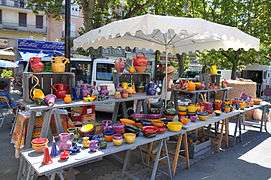 Provençal pottery
Provençal pottery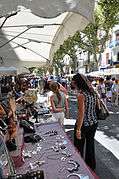 Arts and crafts
Arts and crafts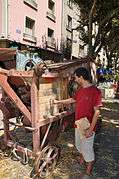 Old agricultural machinery exhibition
Old agricultural machinery exhibition A stand selling olives
A stand selling olives
Service sector
At the end of 2010, the tertiary sector (commerce, services) had 1,176 schools (with 3,072 salaried jobs), in addition to 459 institutions in the administrative sector (together with the health and social sector and education), employing 5,713 people.[91]
Digne-les-Bains is the seat of the Chambre de commerce et d'industrie des Chamber of commerce and industry of Alpes-de-Haute-Provence. It manages the Sisteron-Thèze aerodrome and the J. Gage centre.
Chemins de Fer de Provence employs about 50 people in Digne.[3]
SAMSE, a dealer in building materials, employs 73 people.[98] Still in the area of trade, supermarkets are also important employers. Carrefour employs 250 people and Intermarché has 55 employees.[3]
Orange employs approximately 300 employees.[3] Among computer service companies, Xsalto, offering web hosting, development, and installation, employs 22 staff.[99]
The banking sector provides also some employers. The Groupe Caisse d'Épargne has 50 employees, and the Bank of France has 30 employees.[3] Finally, the Renault dealership is another large private employer, with 28 employees.[100]
Tourism
Economic overview
According to the departmental observatory of tourism, the tourist function is secondary for the municipality, with less than one tourist greeted per capita.[101] However, it offers substantial accommodation capacity, mainly merchant.[102] Several accommodation facilities for tourism exist in the commune:
- There were many hotels in 2008.[103] These included an unclassified hotel,[104] 9 hotels ranked two stars[105] (80% of the rooms of the municipality are in this class of hotels),[106] a three-star hotel[107] and a four-star.[108] Total hotel capacity had changed little between 2008 and 2012, and was in excess of 260 rooms.[109]
- Several campsites[110] occupying a wide range, including a campsite at the farm,[111] a two-star campsite[112] and a three-star.[113] Graded campsites have a capacity of 262 pitches.[114]
- Furnished or unfurnished apartments provide a capacity of hundreds of places.[115][116]
- Bed and breakfast.[117]
- Collective accommodation is also present with, among other things, lodges.[118]
Finally, second homes provide a valuable complement to the capacity.[119] 621 in number, these represent 6.1% of homes. 465 second homes have more than one dwelling.[109][114]
Thermal baths
The spa treats respiratory diseases and rheumatism. They use a hot spring at 50 °C and 110,000 overnight stays are made through this activity. The station is given financial autonomy to hire 76 employees in the high season (September–October).[3] The establishment has a Zen Space and Fitness offering massages of the face and the body, and swimming in thermal water at 33 °C.[120]
- Hydrotheraphy in Digne-les-Bains
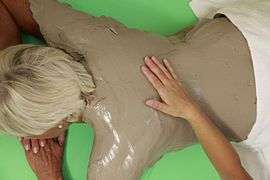 Hydrotherapy in Digne-les-Bains
Hydrotherapy in Digne-les-Bains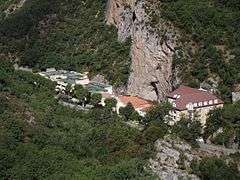 Spa buildings
Spa buildings
Local culture and heritage
Places and monuments
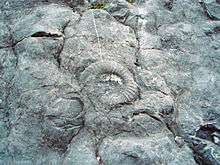
The Dalle à ammonites, a classified site, is a rocky layer dating back 200 million years, where one can find more than 1,500 fossils of ammonites containing some which reach a diameter of 70 centimetres (28 in).
Religious architecture
The commune maintains a southern aspect and has remarkable heritage items including two cathedrals, an archaeological crypt under the Cathedral of Notre-Dame-du-Bourg [Our Lady of the City], the chapels (Saint Pancrace, Our Lady of Lourdes, etc.)
The Cathedral Notre-Dame-du-Bourg, an historical monument,[121] is a Romanesque cathedral whose foundations date back to the 9th century. Victim of numerous attacks and looting, it was renovated at the beginning of the 13th century. Parts from the 11th and 12th centuries still exist. Its white marble altar is of the Merovingian era.
An archaeological crypt in the basement of the cathedral aids in the discovery of the history of Digne-les-Bains. In the crypt is the exact location of the origins of the city, attested by the presence of ancient walls from the 1st century AD. This corresponds to an urban space and implementation of three buildings of Christianity from the 5th century to the 11th century.[122]
The Saint-Jérôme Cathedral, also an historical monument,[123] is a Gothic cathedral from the 15th and 16th centuries. The facade is from the 19th century.
- Cathedrals in Digne-les-Bains
- The façade of Notre-Dame-du-Bourg
- The façade of the cathedral of Saint-Jérome
![]() Media related to Notre-Dame-du-Bourg at Wikimedia Commons
Media related to Notre-Dame-du-Bourg at Wikimedia Commons
![]() Media related to Saint-Jérôme at Wikimedia Commons
Media related to Saint-Jérôme at Wikimedia Commons
The Notre-Dame-de-Lourdes Church was built in 1870 on the Mountain of the Cross, north of Digne, though at the bottom of the slope. The brick walls are its main feature, with its large size.[124]
The chapel of Saint-Vincent belonged to an abbey or priory. It is still in good condition.[124] The Chapel of the Cross, located nearby, is gradually becoming a ruin.[124]
There are numerous churches in the connected communes.
In Courbons, the parish church is Notre-Dame-des-Anges (13th-14th century).[24] It was dedicated to St. Clair in the 17th century.[23] Its single nave consists of three arched barrel bays, and emerges into a square choir.[125] There is also a chapel of Saint-Pierre, south of the village, an establishment which may be very old.[23]
The Church of Dourbes is under the name of Saint-Genest, and the oldest parts are from the 12th and 13th centuries.[23][26] In Villard, the Saint-Jean-Baptiste Chapel probably dates from the 17th century.[23]
In Gaubert, the parish church of Saint-Étienne was built in Romanesque style at the end of the 16th and 17th century.[27] Grand-Saint-Martin farm incorporates some remains of a medieval priory.[23] The chapel of St. Sebastian is situated on the ridge east of the village.[23]
In Sieyès, the Church of Sainte-Marie-Madeleine[23][28] remains along with the Church of Saint-Véran, between the stadium and the cemetery.[23] A more recent chapel was built next to the town hall and school.
There are also two chapels on the mountain which overlooks the ravine of Eaux-Chaudes to the north, Saint-Pons which is in ruins, and the Chapel of Saint-Pancrace. The latter dates from the 17th century and is being restored. It has the distinction of having its bells suspended in a flat metal campanile. The pilgrimage of 12 May, when the priest blessed the sources, remained into the 1950s, and has recently resumed.[126]
Civil and military architecture
- The remains of fortifications can be recognised if one pays attention to the plan of the old town around the central district, built on the heights. Some of the walls and some towers which surrounded the city from the 14th century can still be seen. These remains of ramparts are currently based in the landscape of the dwellings.
- Hotel Thoron by Robine from the 17th century[127]
- The fountain from 1829, which is an historical monument[128]
- The sculptures. From 1983 to 1991, an annual international event of sculpture revealed international talent. Award-winning works, in Carrara marble, adorn roundabouts, squares and public gardens.
Culture
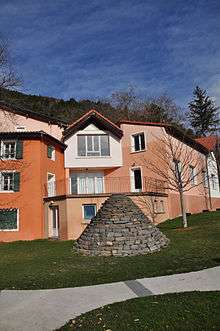
- The Museum of the Haute-Provence Geological Reserve and its butterfly garden.
- The Gassendi Museum is a modern museum enabling the public to move from art to science, and from the old to the contemporary, across a route in time. Its archaeology section was founded in 1889.[129][130]
- CAIRN is an informal art of nature Research Center.[131]
- The Museum of the Second World War contains documents and period objects evoking the strategic role of Digne in alpine defense and the damage suffered.
- Intercommunal library of the Trois Vallées
- The Museum of Alexandra David-Néel, located in her house[132]
- The Botanic Garde of Les Cordeliers
Cultural references
- Victor Hugo's novel Les Misérables begins in Digne. It is here that the protagonist, ex-convict Jean Valjean, is inspired by a kindly bishop to turn his life around.
- The asteroid 10088 Digne was named after the town by its discoverer, Belgian astronomer Eric Walter Elst.
Traditional celebrations
Digne celebrates lavender, a symbol of the region, in the first weekend of August, at the Corso of lavender. A funfair is installed for the occasion, and a fireworks display is organized. A parade of floats is held, including a procession consisting of a dozen floats in lavender and crepon, led by 500 musicians and dancers from various nations. The Corso draws 10-15,000 people to the town each day.
- The Corso of Lavender, in August
 A float of lavender at the Corso in Digne
A float of lavender at the Corso in Digne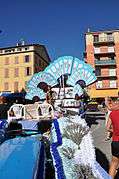 Miss Corso at the Corso of Lavender in Digne
Miss Corso at the Corso of Lavender in Digne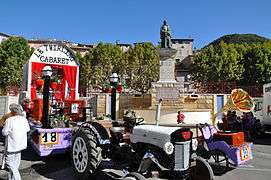 A Corso float before the statue of Gassendi in Digne
A Corso float before the statue of Gassendi in Digne
Arts festivals
In May, every year since 2002, the city has organized a festival of urban culture and music. Initiated by the Ligue de l’Enseignement des Alpes-de-Haute-Provence [League of education of Alpes-de-Haute-Provence] and the L'ADSEA. The festival is now organized by the École du sous Sol [School of the Underground] association.
The objective of this festival is to make urban culture (graffiti, slam, street basketball, hip-hop dance, skateboarding) known to a wider public along with contemporary music (rap, rock, pop, electro) through various artistic and cultural events under the program. A sports tournament closes the event. The Hip Hop dance battle and the basketball tournament are open to girls (two girls and two boys by team for the 4 vs 4 battle and at least one girl by team for the 3 vs 3 basketball tournament). An open stage is offered to amateur and semi-professional teams.
Every spring, each year, the René-Char cultural centre receives cinema personalities and projects art and test films at the Festival les Rencontres cinématographiques de Digne. Its president is Jean-Pierre Castagna.
Sports competitions
Each year since 2004, the Raid des Terres Noires [Raid of the Black Lands] mountain biking event brings together more than a thousand participants.
- Raid of the Black Lands
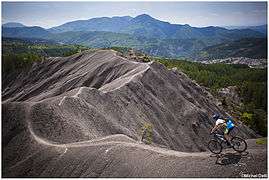 A mountain biking track along the crest of a hill
A mountain biking track along the crest of a hill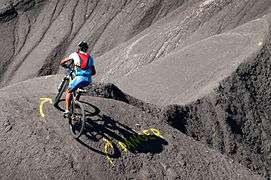 A mountain biker negotiates a tricky turn
A mountain biker negotiates a tricky turn
From 2013, the VTT Rando 04 club organizes the Enduro of the Black Lands, Enduro event.
Created in 1999 by The Athletic Club of Digne, the Half-marathon of the Ammonites connects the village of Barles with the prefecture at the beginning of September, each year until 2002. Its rolling course, measured at 21.1 kilometres (13.1 mi) according to the protocols of the French Athletics Federation, goes through the most spectacular sites of the Haute-Provence Geological Reserve, some of which are world-renowned. Examples of these include the clues of Barles and Péouré, the Vélodrome d’Esclangon [Velodrome of Escanglon], Voile de Facibelle [Veil of Facibelle], the Demoiselles coiffées, the Ichthyosaur, and the Dalle à ammonites.
Its quality organization has been awarded two borders by the guide Le Bipède [The Biped], and placed among the 100 most beautiful French foot races. It welcomed more than 1,550 runners in 4 editions. This sporting event has had a 5th edition in 2013 on the 100th anniversary of the Barles road and in favour of the National League Against Cancer, in memory of Cyril Gues, the first winner of this competition, who died in 2012.
Initiated in 2005 by the Athletic Club of Digne (one edition), the Trail of Cousson was resumed in 2008 by the Athletics Association. The race walking event offers numerous courses in the heart of the Haute-Provence geological Reserve through robines (the famous "muck"), pre-Alpine forests, villages and ascents of the bar of the Dourbes and Cousson. Free racing and animations for children as well as heritage walks are also organized parallel to sports competitions. The event also fits into an exemplary sustainable development policy which gives it national recognition.
Heraldry
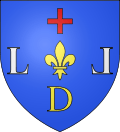 |
The arms of Digne-les-Bains are: "Azure to a fleur-de-lis of Or accompanied at head by a cross of gules, at flanks with two "L" letters capitalised faced Argent and in point of a letter "D" capitalised also of Or"[133] |
These arms are not attested before the 17th century and the above composition is only one variant among many others existing. The "L" can be gold and can be replaced by silver lions. There are also versions without the golden "L" or lion: "azure to a fleur de lis of gold, accompanied at head by a cross of silver with a letter "D" of the same at the point". The latest version is "azure to a cross of gold at head and a "D" of the same at head". The cross is an evocation of the episcopal see, and the "L", perhaps, is a souvenir of a concession of Louis II of Anjou, from the beginning of the 15th century.[134]
Gabriel Gillybœuf proposed in the early 1980s to replace the capitalised "D" with a fountain expressed in heraldic terms by "a bezant fess, wavy silver and azure" (while maintaining the cross, fleur-de-lis, and capitalised "L" respectively).[134]
The city was jointly owned by the Counts of Provence and the Bishops of Digne. Hence the arms: The cross symbolises the bishopric, the fleur-de-lis as Charles of Anjou, Count of Provence. The letter "D" is the letter of the city. The letters "L" have been added under Louis XIV, King of France, Count of Provence and Forcalquier.[133]
Personalities linked to the commune
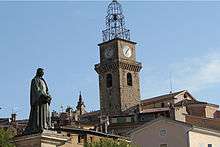
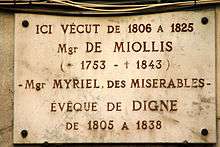
Religious
- Saint Domnin of Digne and Saint Vincent of Digne, early bishops of Digne. They were North African Berbers and were part of one of the first missionary teams sent to evangelise Provence.[135]
- Douceline of Digne, (1214-1274) devoted all his life to the poor and the sick, and his brother Hugh of Digne, was also religious
- Bienvenu de Miollis, (1753-1843), Bishop of Digne, inspiration for the kind bishop in Les Misérables[136]
- Christian Chessel (1958-1996), born in Digne, was a White Father who was murdered in Tizi Ouzou
Nobles, political and military
- The family of the Porcellets, of the House of Provence.
- Jean-Pierre Alexandre Dieudé (1743-1819), general of the armies of the Republic and the Empire, died in Digne.
- Louis Alexis Desmichels (1779-1845), born in Digne, cavalry general
- Hippolyte Fortoul (1811-1856), Minister of Marine (1851) and of Public Instruction.
- Frédéric Aillaud, Member of Parliament under the Third Republic, died at Digne in 1924.
- Jean-Louis Bianco born in 1943 in Neuilly-sur-Seine, politician, former Minister, former Mayor of Digne, former MP and former president of the conseil général of the Alpes de Haute Provence.
- The Taxis family
Scientific
- Pierre Gassendi (1592-1655), mathematician, astronomer and philosopher born at Champtercier, near Digne
- Jean-Baptiste Ricavy (1755-1808) doctor of medicine, professor at the school of Medicine of Montpellier, writer of two books: Traité des eaux minérales de Digne [Treaty of mineral waters of Digne] (1789)[137] and Observations sur différentes maladies [Observations on various diseases] (1790)[138]
- Alphonse Eugène Beau also known as Beau de Rochas (1815-1893), an engineer and thermodynamician born on 9 April 1815 in Digne, and inventor of the Cycle of Beau de Rochas
- Simon-Jude Honnorat (1783-1852), lexicographer
- Alexandra David-Néel (1868-1969), Explorer and French writer, bought a property at Digne in 1928. She died there in 1969.
- Tristan Louis, born in Digne on 28 February 1971, inventor of podcasting
Artists
- Paul Martin, born and died in Digne (1830-1903), watercolour painter[139]
- Melchior Jaubert, born in Digne and died in Grenoble (1848-1913), painter and watercolourist.
- Henri Jaubert, born in Digne and died in Périgueux (1860-1936), brother of the preceding, painter and watercolourist.
- Paul-Alexandre Arnoux (1884-1973), French poet born in Digne on November 27, 1884.
- Jean-Pierre Castagna (born in 1946 in Digne), President of the Rencontres cinématographiques de Digne-les-Bains.
- Jean Daviot, artist born in Digne on February 20, 1962
- Jean-Philippe Argento, born in Digne on 16 May 1972, singer-songwriter who collaborated with Jean-Pascal Lacoste, Sandra Lou, Didier Gustin and also Pauline.
- Greg Théveniau musician born in Digne in 1973.
- Raphaël-Désiré Freida born May 26, 1877 in Digne, died 25 December 1942 in Paris. Painter, illustrator, engraver, a member of the Société des Artistes Français [Society of French Artists].
Sport and others
- Alain Boghossian, footballer born 27 October 1970 in Digne played for the Digne club 1987-1988 and 1988-1989 seasons.
- Mickaël Maschio (born in 1973 in Digne) motocross motorcyclist
- Grégory Bernard (born in 1984 in Digne), player of Rugby Union
- Cyril Féraud (born in 1985 in Digne), journalist and television presenter
- William Reymond, French writer and journalist
- Nicolas Lebrun (born in 1973) professional triathlete
- Gérard Honnorat, born in Digne December 11, 1960, former champion of France of triathlon, duathlon France teams former coach then Triathlon; national technical director Assistant to the French federation of triathlon.
- Jean Rolland born July 27, 1935 in Digne, deceased racing driver racing on September 17, 1967 at the Montlhéry circuit.
- Kenny "KennyS" Schrub, professional Counter-Strike: Global Offensive player for Team EnVyUs born in 1995.
- Antoine Méo (born in 1984 in Digne), multiple Motocross Enduro world champion
See also
- Chemins de Fer de Provence
- Gare de Digne
- Halte de Plan d'eau des Ferréols
- Gare de Gaubert-Le Chaffaut
- Route Napoléon
- Commandery of Digne (of the Knights Templar)
- Diocese of Digne
- Communes of the Alpes-de-Haute-Provence department
- List of former communes of Alpes-de-Haute-Provence
- List of prefects of Alpes-de-Haute-Provence
- List of the Bishops of Digne
- List of works by Louis Botinelly
- Armorial of the communes of Alpes-de-Haute-Provence
References
- 1 2 3 4 de La Torre, Michel (1989). Alpes-de-Haute-Provence: le guide complet des 200 communes [Alpes-de-Haute-Provence: The complete guide to 200 communes] (in French). Paris: Deslogis-Lacoste. ISBN 2-7399-5004-7.
- 1 2 3 "Digne-les-Bains" [Digne-les-Bains] (in French). Retrieved 7 April 2015.
- 1 2 3 4 5 6 7 "Cantons de Digne-les-Bains". Le Trésor des régions. See section "Cantons de Digne-les-Bains". Retrieved 7 April 2015.
- ↑ "Se déplacer en ville : le TUD" [Getting around the city: the TUD] (in French). Archived from the original on 10 February 2011. Retrieved 7 April 2015.
- ↑ "La sécurité civile" [Civil security] (in French). DDRM. p. 39. Dossier départemental sur les risques majeurs dans les Alpes-de-Haute-Provence. Archived from the original on 22 September 2012. Retrieved 7 April 2015.
- 1 2 3 "Notice communale" [Communal notice]. Gaspar (in French). Ministère de l’Écologie, du développement durable, des transports et du logement. Archived from the original on 21 February 2014.
- ↑ Préfecture des Alpes-de-Haute-Provence, DDRM, p. 37.
- 1 2 Préfecture des Alpes-de-Haute-Provence, DDRM, p. 96.
- ↑ Préfecture des Alpes-de-Haute-Provence, DDRM, p. 80.
- ↑ Préfecture des Alpes-de-Haute-Provence, DDRM, p. 81.
- ↑ "Informations commune" [Commune information] (in French). DICRIM. Retrieved 7 April 2015.
- ↑ Préfecture des Alpes-de-Haute-Provence, DDRM, p. 24.
- ↑ Préfecture des Alpes-de-Haute-Provence, DDRM, p. 25.
- ↑ Préfecture des Alpes-de-Haute-Provence, DDRM, p. 32.
- ↑ "Votre sélection : commune DIGNE-LES-BAINS (04070)" [Your selection: Commune DIGNE-LES-BAINS (04070)]. Sisfrance (in French). BGRM. Archived from the original on 13 April 2015. Retrieved 7 April 2015.
- ↑ "fiche 40210" [File 40210]. Sisfrance (in French). BRGM. Archived from the original on 13 April 2015. Retrieved 7 April 2015.
- ↑ "fiche 40047" [File 40047]. Sisfrance (in French). BRGM. Archived from the original on 13 April 2015. Retrieved 7 April 2015.
- ↑ "fiche 40049" [File 40049]. Sisfrance (in French). BRGM. Archived from the original on 13 April 2015. Retrieved 7 April 2015.
- ↑ "fiche 1130045" [File 1130045]. Sisfrance (in French). BRGM. Archived from the original on 13 April 2015. Retrieved 7 April 2015.
- ↑ "fiche 50033" [File 50033]. Sisfrance (in French). BRGM. Archived from the original on 13 April 2015. Retrieved 7 April 2015.
- ↑ "fiche 40072" [File 40072]. Sisfrance (in French). BRGM. Archived from the original on 13 April 2015. Retrieved 7 April 2015.
- ↑ "fiche 40176" [File 40176]. Sisfrance (in French). BRGM. Retrieved 7 April 2015.
- 1 2 3 4 5 6 7 8 9 10 11 12 13 "Digne" [Digne]. archaeoprovence (in French). Retrieved 7 April 2015.
- 1 2 3 Baratier, Duby & Hildesheimer (1969), p. 172
- ↑ Parc naturel du Luberon, Autour de l’An Mil en pays de Forcalquier, catalogue d’exposition, 2007, p. 31.
- 1 2 3 Baratier, Duby & Hildesheimer (1969), p. 173
- 1 2 3 Baratier, Duby & Hildesheimer (1969), p. 176
- 1 2 3 Baratier, Duby & Hildesheimer (1969), p. 200
- 1 2 Alphand (1989), pp. 296–298
- ↑ Charles Rostaing, Essai sur la toponymie de la Provence (depuis les origines jusqu’aux invasions barbares), Laffite Reprints, Marseille, 1973 (1re édition 1950), p. 165–166.
- ↑ Nègre, Ernest (1990). Toponymie générale de la France : étymologie de 35 000 noms de lieux, vol. 1 : Formations préceltiques, celtiques, romanes. Genève: Librairie Droz. p. 623. ISBN 978-2-600-02884-4. Publications romanes et françaises.
- 1 2 3 4 5 "notice communale de Digne-les-Bains" [Communal notice of Digne-les-Bains]. Cassini (in French). EHESS. Retrieved 7 April 2015.
- ↑ Zérubia (2012), p. 101
- ↑ Zérubia (2012), p. 99
- ↑ F. GUICHARD, Essai sur le cominalat dans la ville de Digne, 2 vol., Digne, 1846 Google books
- ↑ Aurell, Martin; Coulet, N.; Boyer, Jean-Pierre (2005). La Provence au Moyen Age [Provence in the Middle Ages] (in French). Aix-en-Provence.
- 1 2 Varitille, F. (2013). Digne à la fin du Moyen-Age : Politique et société [Digne at the end of the Middle Ages: Politics and Society] (in French). Paris. Mémoire soutenu à Paris 1 Panthéon-Sorbonne, dir. O. Mattéoni.
- ↑ Baratier (1961), p. 72
- 1 2 Yvette Isnard, « Les dynasties seigneuriales d’Oraison », Chroniques de Haute-Provence, 2012, no 368, p. 36.
- ↑ Cru, Jacques (2001). Histoire des Gorges du Verdon jusqu’à la Révolution [History of the Verdon Gorges to the Revolution] (in French). coedition Édisud and Parc naturel régional du Verdon. p. 200. ISBN 2-7449-0139-3.
- ↑ Gustave Lambert, Histoire des guerres de religion en Provence : 1530-1598 (tome 2), Nyons, Chantemerle, 1970 (édition originale : 1869), p. 352.
- 1 2 Yvette Isnard,"Les dynasties seigneuriales d’Oraison", p. 37.
- ↑ Michel Vovelle, « Les troubles de Provence en 1789 », carte 154 et commentaire, in Baratier, Duby & Hildesheimer (1969)
- ↑ Alphand (1989), p. 304
- ↑ Alphand (1989), p. 311
- ↑ Alphand (1989), p. 303
- ↑ Alphand (1989), p. 17
- ↑ Michel Vovelle, « Diffusion et répression du mouvement fédéraliste en 1793 », carte 157 et commentaire, in Baratier, Duby & Hildesheimer (1969)
- ↑ Alphand (1989), p. 333
- ↑ "Deux siècles d'activités préfectorales" [Two centuries of prefectural activities] (in French). Archived from the original on 28 April 2007.
- 1 2 3 Labadie (2013), p. 9
- 1 2 3 Labadie (2013), p. 16
- ↑ Labadie (2013), p. 18
- 1 2 3 "Débuts de la Résistance dans les Basses Alpes" [Beginning of the Resistance in the Alps Basses]. Association Basses-Alpes 39-45 (in French). Retrieved 8 April 2015.
- ↑ Garcin (2004), p. 2
- ↑ "Département des Alpes-de-Haute-Provence en 1939-1945" [Department of Alpes-de-Haute-Provence in 1939-1945]. ajpn.org (in French). Retrieved 8 April 2015.
- 1 2 Reymond (1993), p. 24
- 1 2 Garcin (2004), p. 5
- ↑ Reymond (1993), p. 138
- ↑ Henri Julien (directeur de publication), Guide du débarquement de Provence, 15 août 1944, Digne-les-Bains, Éditions de Haute-Provence, 1994, (ISBN 2-909800-68-7), p. 127.
- ↑ "Les dépôts de P.G. de l'Axe en mains françaises" [French prisoner of war camps of the Axis] (in French). Retrieved 8 April 2015.
- ↑ Besson, André (2005). "27 et 30 janvier 1948 : la double catastrophe aérienne du massif du Cheval Blanc des appareils C-47 Dakota et B-17 Flying Fortress du 61st Troop Carrier Group, 14th Squadron de l'USAF" [27 and 30 January 1948: The double Cheval Blanc massif air disaster of C-47 Dakotas and B-17 Flying Fortress of the 61st Troop Carrier Group, 14th Squadron of the USAF]. Chroniques de Haute-Provence (in French). 354: 122–125.
- ↑ Mark Deen. "Germanwings Airbus A320 Crashes in Digne Region in France - Bloomberg Business". Bloomberg.com. Retrieved 28 March 2015.
- ↑ Jean Garcin, De l'Armistice à la Libération dans les Alpes de Haute-Provence 17 juin 1940 - 20 août 1944. Chronique : essai sur l'histoire de la Résistance avec un prologue 1935-1940 et un épilogue 1944-1945, Digne : Imprimerie B. Vial, 1990. p.229.
- ↑ "La Libération" [The Liberation]. Basses-Alpes 39-45 (in French). Retrieved 8 April 2015.
- ↑ François de Bouchony, « Le parti socialiste a besoin de conforter son ancrage municipal », La Provence, 3 février 2014, p.3.
- ↑ La Provence
- ↑ "Liste des maires" [List of mayors] (PDF) (in French). Préfecture des Alpes-de-Haute-Provence. 2014. Retrieved 8 April 2015.
- ↑ Résultats dans les Alpes-de-Haute-Provence
- ↑ "LA VILLE DE DIGNE-LES-BAINS DANS LES ALPES DE HAUTE-PROVENCE" [The town of Digne-les-Bains in the Alpes de Haute-Provence] (in French). Retrieved 8 April 2015.
- ↑ ja:釜石市#姉妹都市・友好都市
- ↑ Robert Niel, Le Roman des brigands dans les Basses-Alpes de 1789 à 1802, Impr. B. Vial (Digne-les-Bains), 2007, 190 p., (ISBN 978-2-9530563-1-0).
- ↑ "Résultats du recensement de la population - Digne-les-Bains". INSEE.
- ↑ "Recensement de la population au 1er janvier 2006". INSEE.
- ↑ "Populations légales 2009 en vigueur le 1er janvier 2012". INSEE.
- ↑ "Ville de Digne-les-Bains" (in French). Retrieved 8 April 2015.
- ↑ "Liste des écoles de la circonscription de Digne" [List of schools of the district of Digne] (in French). Archived from the original on 20 July 2011.
- ↑ "Collèges publics" [Public Colleges] (in French). Archived from the original on 20 July 2011.
- ↑ "Lycées professionnels" [Vocational schools] (in French). Archived from the original on 21 February 2014.
- ↑ "Lycées publics" [Public High Schools] (in French). Archived from the original on 21 February 2014.
- ↑ "Enseignement supérieur" [Higher Education] (in French). Archived from the original on 21 February 2014.
- ↑ "Carte des Brigades de Gendarmerie" [Map of Gendarmerie Brigades] (PDF). Groupement de gendarmerie départementale des Alpes-de-Haute-Provence, (in French). Préfecture des Alpes-de-Haute-Provence. Retrieved 8 April 2015.
- ↑ "Présentation du groupement de gendarmerie départementale" [Presentation of the provincial gendarmerie group]. Préfecture des Alpes-de-Haute-Provence (in French). Retrieved 8 April 2015.
- ↑ "Mosquée de Digne-les-Bains" [Mosque of Digne-les-Bains] (in French). Archived from the original on 9 February 2015. Retrieved 8 April 2015.
- ↑ "Chapelle de Digne" [Chapel of Digne] (in French). Archived from the original on 9 February 2015. Retrieved 8 April 2015.
- ↑ "Assemblée de Dieu Eglise Evangélique" [Assembly of God Evangelical Church] (in French). Retrieved 8 April 2015.
- ↑ "Impots locaux à Digne les Bains" [Local taxes in Digne les Bains] (in French). taxes.com. Retrieved 7 April 2015.
- ↑ INSEE (2012), p. 5
- ↑ INSEE (2012), p. 8
- 1 2 INSEE (2012), p. 7
- 1 2 3 INSEE (2012), p. 17
- 1 2 3 Ministère de l'Agriculture, « Orientation technico-économique de l’exploitation », Recensements agricoles 2010 et 2000. link
- 1 2 "Exploitations agricoles en 1988 et 2000". INSEE.
- ↑ "SA ALP'AGRI". Retrieved 8 April 2015.
- ↑ "Terroirs perdus, terroirs constants, terroirs conquis : vigne et olivier en Haute-Provence XIXe-XXIe siècles". 2007. pp. 56 and 59. Méditerranée, 109. Retrieved 8 April 2015.
- ↑ "Marché du mercredi de Digne-les-Bains" [Wednesday market in Digne-les-Bains] (in French). Retrieved 8 April 2015.
- ↑ "Marche du samedi de Digne-les-Bains" [Saturday market in Digne-les-Bains] (in French). Retrieved 8 April 2015.
- ↑ "SAMSE". Retrieved 8 April 2015.
- ↑ "XSALTO". Retrieved 8 April 2015.
- ↑ "ESPACE AUTOMOBILES DIGNOIS". Retrieved 8 April 2015.
- ↑ Anonymous (2007), p. 6
- ↑ Anonymous (2007), p. 7
- ↑ Anonymous (2007), p. 11
- ↑ Anonymous (2007), p. 13
- ↑ Anonymous (2007), p. 16
- ↑ Anonymous (2007), p. 12
- ↑ Anonymous (2007), p. 17
- ↑ Anonymous (2007), p. 18
- 1 2 "Hébergements touristiques des communes, 2008, 2009 et 2012" [Tourist accommodation of Commons, 2008, 2009 and 2012] (in French). Retrieved 8 April 2015.
- ↑ Anonymous (2007), p. 21
- ↑ Anonymous (2007), p. 22
- ↑ Anonymous (2007), p. 25
- ↑ Anonymous (2007), p. 27
- 1 2 Insee, Dossier local, p. 18.
- ↑ Anonymous (2007), p. 32
- ↑ Anonymous (2007), p. 36
- ↑ Anonymous (2007), p. 38
- ↑ Anonymous (2007), p. 30
- ↑ Anonymous (2007), p. 44
- ↑ "Thermes Digne-les-Bains". Retrieved 7 April 2015.
- ↑ "Monuments historiques". Merimee. Retrieved 8 April 2015.
- ↑ "Crypte archéologique". Retrieved 8 April 2015.
- ↑ "Monuments historiques". Merimee. Retrieved 8 April 2015.
- 1 2 3 Panarotto (2007), p. 147
- ↑ Jean-Christophe Labadie, Des Anges, Musée départemental d’art religieux, catalogue de l’exposition à la cathédrale Saint-Jérôme (5 juillet-30 septembre 2013), 2013, (ISBN 978-2-86004014-3), p. 29.
- ↑ Panarotto (2007), p. 146
- ↑ "Hôtel Thoron de la Robine". Merimee. Retrieved 8 April 2015.
- ↑ "Fontaine monumentale". Merimee. Retrieved 8 April 2015.
- ↑ "Official site". Retrieved 7 April 2015.
- ↑ Géraldine Bérard, Carte archéologique des Alpes-de-Haute-Provence, Académie des Inscriptions et Belles-Lettres, Paris, 1997, p. 58.
- ↑ "LE CAIRN ( Centre d'Art Informel de Recherche sur la Nature)".
- ↑ Office de tourisme [Office of tourism]
- 1 2 "GASO - la banque du blason".
- 1 2 En quête d’identité : Armoiries et sceaux en Haute Provence, Archives départementales des Alpes-de-Haute-Provence, 2009, p. 16
- ↑ Vincent J. O’Malley, Saints of Africa p. 58, 2001, (ISBN 0-87973-373-X).
- ↑
- ↑ Traité des eaux minérales de Digne, Ricavy (Médecin), Aix. Les frères Mouret,1789, 56 p.
- ↑ Observations sur différentes maladies faites par M. Ricavy,... pour servir de suite à son Traité sur les eaux minérales de Digne, Ricavy (Médecin), Guichard fils, 1790, 26p.
- ↑ Baratier, Duby & Hildesheimer, p. 153.
Bibliography
- Anonymous (2007). "Atlas de l'hébergement touristique" [Atlas of tourist accommodation] (PDF) (in French). Observatoire départemental du tourisme. Retrieved 7 April 2015.
- Alphand, Patrice (1989). "Les Sociétés populaires". La Révolution dans les Basses-Alpes. Annales de Haute-Provence, bulletin de la société scientifique et littéraire des Alpes-de-Haute-Provence. 307.
- Baratier, Édouard (1961). La démographie provençale du XIIIe au XVIe siècles, avec chiffres de comparaison pour le XVIIIe siècle. Démographie et société. 5. Paris: SEVPEN/EHESS.
- Baratier, Édouard; Duby, Georges; Hildesheimer, Ernest (1969). Atlas historique. Provence, Comtat Venaissin, principauté d’Orange, comté de Nice, principauté de Monaco [Historical Atlas . Provence, Venaissin County , Principality of Orange County of Nice , Principality of Monaco] (in French). Paris: Librairie Armand Colin.(BnF no FRBNF35450017h)
- Garcin, Jean (2004). "La résistance armée". Basses-Alpes 39-45. 7.
- INSEE (28 June 2012). "Évolution et structure de la population" [Evolution and structure of the population] (PDF) (in French). INSEE. Retrieved 8 April 2015.
- Labadie, Jean-Christophe (2013). Les Maisons d’école [The schoolhouses] (in French). Digne-les-Bains: Archives départementales des Alpes-de-Haute-Provence. ISBN 978-2-86-004-015-0.
- Panarotto, Serge (2007). Chapelles de Provence : chapelles rurales et petits édifices religieux. Patrimoines. Aix-en-Provence: Édisud. ISBN 978-2-7449-0817-0.
- Reymond, Guy (1993). "Ça sentait la liberté et l’espérance" : histoire de la libération de Digne, 14–20 août 1944. Les Petites affiches.
- Zérubia, Roger (2012). "L'habitat rural antique des Hostelleries de Gaubert à Digne". Chroniques de Haute-Provence. 368.
External links
| Wikimedia Commons has media related to Digne-les-Bains. |
- City council website (French)
- Tourist office website (French)
- Ville de Digne-les-Bains (French)
- Map and Information
